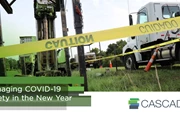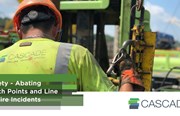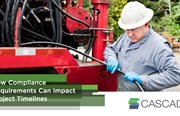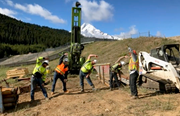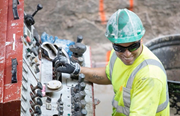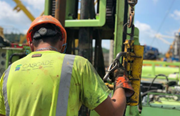General Safety Tips: Injection Sites
By: CascadeInjection sites often employ much of the same equipment that a drilling site will employ, and many of the hazards associated with the setup of a standard drilling site are the same as an injection site. However, there are a few hazards specific to injection sites that need to be addressed, including storm drain run-off, caustic injection material and high pneumatic pressures. Let’s look at these differences to help you prepare for your next injection project:
Storm Drain Protection
When an injection crew arrives onsite, one of the first things the crew should do is identify storm drains and create a secondary containment around the drain that will prohibit any unwanted products from entering them. This can be accomplished in a myriad of ways, but typically the most effective way to do so is to lift the drain cover and place Visqueen, or some other impermeable layer, underneath the drain. In addition to placing Visqueen underneath the drain, can be used to create a berm around the storm drain. If these materials are not available, bentonite or some other absorbent material can be used to create a berm.

AN EXAMPLE OF A MIXING PLATFORM SET UP INSIDE OF A SECONDARY CONTAINMENT
Aside from a secondary containment underneath the storm drains, all injection platforms should have a secondary containment underneath them. This ensures that any unexpected release of material is contained in the unlikely event of a tank overfill or spill. Depending upon the logistics of a site, a splash shielding should be implemented in areas where potential splashing could damage or negatively affect anything nearby, such as a building or local flora.

STORM DRAIN PROTECTED AGAINST UNWANTED RUNOFF
Injection Materials
There is a lot of variation between the products that are used for injection. Care must be used to ensure the safety of all personnel that handle these products. Let’s look at permanganate, a product commonly injected for subsurface chemical remediation. When working with permanganate, it is important to make sure there is an abundance of neutralizer on hand. Because of the caustic nature of most injection materials, personal protective equipment (PPE) must be worn including Tyveks, gloves, face shields and goggles When working with permanganate, or any fine powders, employees should never use a sleeve or other part of the outer PPE to wipe his/her face.
Injections: Operational
The actual injections are the most hazardous part of any injection project. They typically incorporate the standard hazards of drilling with some additional unique hazards. Most Injection points are set utilizing a drilling rig. After the points are set, a well manifold, through which the injection materials will flow, is affixed to the injection point. Prior to injection starting, a clear line of sight must be established between the driller and injection operator. If this is not possible due to visual obstruction, the crew should utilize some form of communication either via hand held radios or use a third person to triangulate between the two. Once visual contact has been made, it is imperative for the crew to have predetermined hand and arm signals to relay commands such as “start pumping”, “stop pumping”, “increase the flow rate”, “decrease the flow rate”, etc. At the onset of each injection, the crew needs to ensure that the pressure relief valve is closed, whip checks are properly secured, and the injection valves are open. If they are not open, it could lead to elevated pressure and result in a burst line or damage to the pump.

CLEAR LINE OF SITE FROM INJECTION OPERATOR TO DRILLER
During pneumatic fracturing with nitrogen, pressures are typically higher than during other injection events. To ensure personnel safety, crew members need to stay at least 50’ away from any injection hose while the injection is taking place. Another key concern while performing pneumatic injecting is to ensure that when using packers, they are chained to the rig and secured. Packers can explode and seals can break which leads to the packer being forcefully ejected from the hole. When working with high-pressure gas it is very important to remember that, unlike liquids, gases can be compressed. If these compressed gases are allowed to expand they can lead to a drop-in temperature, which depending on factors such as humidity or water in the system, could lead to valves or regulators freezing in the open or closed position. It is also important to note that when dealing with high-pressure systems the pressure rating is only equal to the lowest rated component. One valve that isn’t rated adequately means that the entire system isn’t rated properly.
OTHER SAFETY TIPS
There is a lot more to consider when discussing safety on an injection site. Constant attention to detail must be used, and due to the variety of injection setups, there will always be a need to look for the safest way to approach each unique scenario. Here are some general safety tips to keep in mind on all injection projects:
- Ensure a plentiful supply of face shields. These tend to get dirty quickly and can impair vision. Best practice is to use spray bottles of water and wipes to keep them clean
- Crews should wear rubber, steel-toed boots in all climates. It’s not uncommon during injecting for water to surface, making the ground wet and slippery
- Crew should ensure that the minimum safe distances for equipment is clearly communicated beforehand to all personnel on site and an adequate exclusion zone is maintained.
- Enough safety gear should be kept on site to provide site visitors with the proper PPE if they don’t have it
- When injecting food grade material, the material should be kept in animal-proof containers. Animals are attracted to food grade injection materials, such as molasses, and will try to crawl into containers and become trapped or possibly drown
- A buddy team should always be used when moving hose, even if it isn’t high pressure. Aside from the strain of on one person moving a hose, it’s hard to see corners and edges when moving the hose around site. Contact with these hazards may damage or puncture the hose and leave no visible marks
- Hoses need to be constantly checked for punctures or holes. A small hole in an injection hose will become a major safety issue very quickly
- T the exclusion zone should as large as the site will allow. If a hose under pressure were to burst, any product that may be released could travel a substantial distance
- If the job requires using a public fire hydrant, which most do, make sure that you have measured it out and have an adequate amount of hose to reach without creating trip hazards, and the hydrant and hoses are secure

